Intel Core i7-11700K Review: Blasting Off with Rocket Lake
by Dr. Ian Cutress on March 5, 2021 4:30 PM EST- Posted in
- CPUs
- Intel
- 14nm
- Xe-LP
- Rocket Lake
- Cypress Cove
- i7-11700K
Gaming Tests: F1 2019
The F1 racing games from Codemasters have been popular benchmarks in the tech community, mostly for ease-of-use and that they seem to take advantage of any area of a machine that might be better than another. The 2019 edition of the game features all 21 circuits on the calendar for that year, and includes a range of retro models and DLC focusing on the careers of Alain Prost and Ayrton Senna. Built on the EGO Engine 3.0, the game has been criticized similarly to most annual sports games, by not offering enough season-to-season graphical fidelity updates to make investing in the latest title worth it, however the 2019 edition revamps up the Career mode, with features such as in-season driver swaps coming into the mix. The quality of the graphics this time around is also superb, even at 4K low or 1080p Ultra.
For our test, we put Alex Albon in the Red Bull in position #20, for a dry two-lap race around Austin. We test at the following settings:
- 768p Ultra Low, 1440p Ultra Low, 4K Ultra Low, 1080p Ultra
In terms of automation, F1 2019 has an in-game benchmark that can be called from the command line, and the output file has frame times. We repeat each resolution setting for a minimum of 10 minutes, taking the averages and percentiles.
| AnandTech | Low Resolution Low Quality |
Medium Resolution Low Quality |
High Resolution Low Quality |
Medium Resolution Max Quality |
| Average FPS |  |
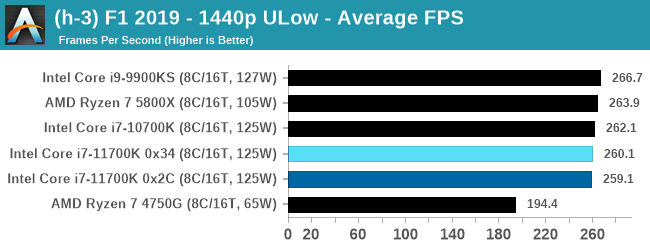 |
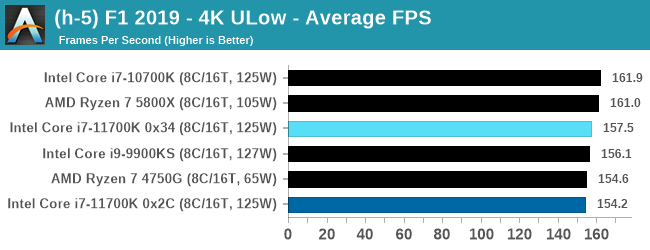 |
 |
| 95th Percentile | 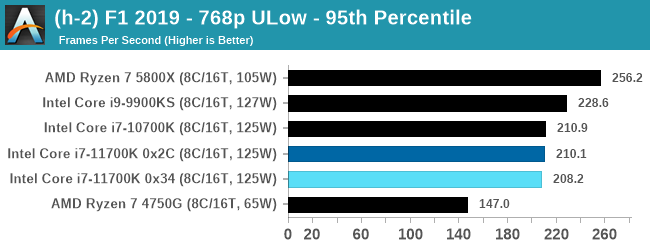 |
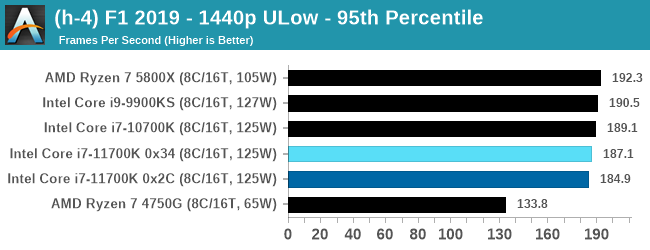 |
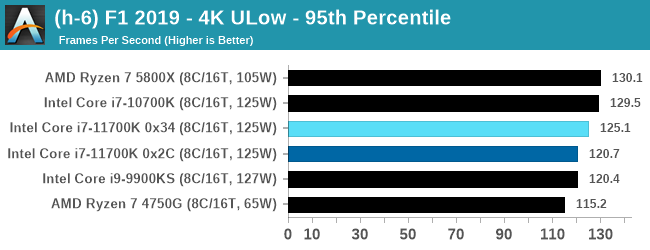 |
 |
The Ego engine is usually a good bet where cores, IPC, and frequency matters. Despite this, the 11700K isn't showing much of a generational improvement.
All of our benchmark results can also be found in our benchmark engine, Bench.












541 Comments
View All Comments
TheinsanegamerN - Monday, March 8, 2021 - link
They're the same chip, the only difference is clock speeds. Dont get your hopes up, RKL is a total dud, much like Williamette was.Samus - Saturday, March 6, 2021 - link
blppt - my concern is that AMD may have a superior IPC, but the real fruit comes from the manufacturing process. Intel is still (somewhat) competitive at 14nm and that in itself is quite unbelievable. Imagine where this chip would be on 7nm or 10nm, at 6GHz+ and more cores with 2-3x the cache.That said, this victory may be short lived because AMD is basically taking advantage of the embarrassing execution Intel has repeated, much like they did 20 years ago with the P4 (albeit that was an architecture failure, not a manufacturing process failure)
Thesubtlesnake - Saturday, March 6, 2021 - link
Intel's latest 10nm process delivers *slower* clocks than its 14nm one. So, no, 6 GHz is not on the table. I imagine that when the transition to 7nm, Intel will be able to achieve moderately faster clock speeds than with 14nm.Otritus - Sunday, March 14, 2021 - link
10nm SF is good enough for 5 GHz. 10nm ESF can clock higher, so Intel's latest (but unreleased) process should match 14nm. I would not expect 7nm to clock higher than 14nm because it is becoming very clear that 5Ghz+ is just a waste of power and transistors, so i would not expect 7nm architectures to be designed to clock higher. We either are getting lots of IPC or just over 5GHz.Slash3 - Friday, March 5, 2021 - link
Mad lad.edved - Friday, March 5, 2021 - link
Nice write-up. Thank you.lucasdclopes - Friday, March 5, 2021 - link
Power efficiency is abysmal on this one.CiccioB - Friday, March 5, 2021 - link
No, it is not. It lower than AMD's efficiency, but it not that bad for being based on such an old process.PixyMisa - Friday, March 5, 2021 - link
So it's abysmal, but that's only to be expected?Spunjji - Saturday, March 6, 2021 - link
Not bad for an old process is still abysmal by the standards of 2021. No wonder Apple dropped them like a hot rock.